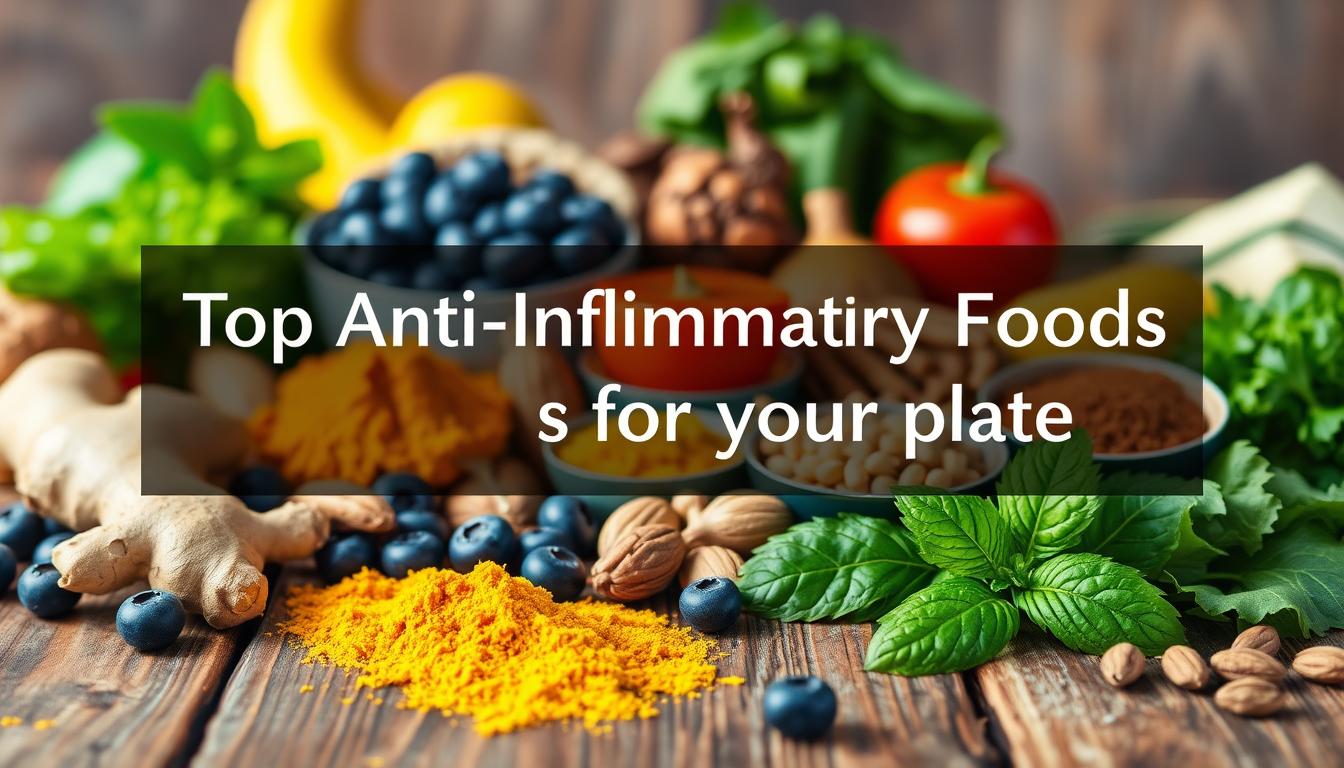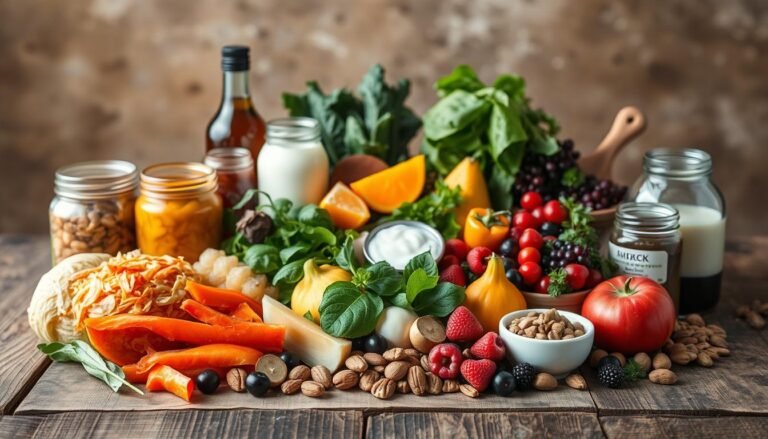Could the foods on your plate be silently fighting or fueling inflammation in your body? Understanding the power of best anti-inflammatory foods can transform your health from the inside out. Your diet plays a critical role in managing bodily inflammation. Making strategic food choices can help you naturally reduce inflammatory responses.
Natural ways to reduce inflammation start with what you eat. Foods that fight inflammation naturally can protect your cells and boost your immune system. They can also prevent chronic health conditions. From vibrant berries to nutrient-packed leafy greens, anti-inflammatory diet tips can help you create meals that support your body’s healing processes.
This comprehensive guide will walk you through the most effective anti-inflammatory foods. You’ll learn how simple dietary changes can make a profound difference in your overall wellness. You’ll discover powerful nutrition strategies that can help calm inflammation and promote long-term health.
Key Takeaways
- Diet plays a crucial role in managing body inflammation
- Certain foods can naturally reduce inflammatory responses
- Strategic food choices support cellular health
- Anti-inflammatory nutrition can prevent chronic conditions
- Simple dietary changes can significantly improve overall wellness
Understanding Inflammation and Its Impact on Your Health
Inflammation is your body’s way to fight off harm. It’s a complex process that helps you heal. Knowing about different types of inflammation can guide you to eat better for your health.
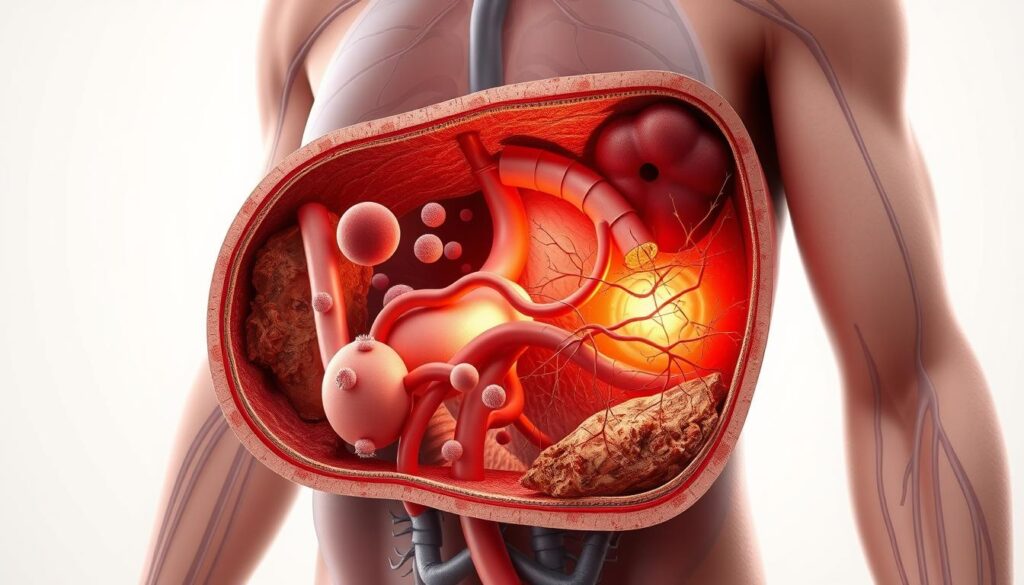
Acute vs. Chronic Inflammation: What’s the Difference?
Your body has two main types of inflammation:
- Acute Inflammation: A quick response to injury or infection
- Typically lasts a few days
- Helps healing process
- Involves swelling, redness, and warmth
- Chronic Inflammation: A long-lasting inflammatory response
- Can last months or years
- Linked to serious health conditions
- Often triggered by diet and lifestyle
How Diet Influences Inflammation
What you eat can cause inflammation. Foods like processed items, refined sugars, and unhealthy fats can lead to inflammation. On the other hand, foods like fruits, vegetables, and omega-3 rich fish can fight inflammation.
| Inflammatory Foods | Anti-Inflammatory Alternatives |
|---|---|
| Refined Sugar | Fresh Berries |
| Processed Meats | Fatty Fish |
| Trans Fats | Olive Oil |
Signs Your Body Is Fighting Inflammation
Knowing how to fight inflammation starts with noticing your body’s signs. Look out for fatigue, joint pain, digestive problems, and unexplained weight gain. By paying attention and making the right food choices, you can help your body heal.
The Power of Antioxidant-Rich Berries and Fruits
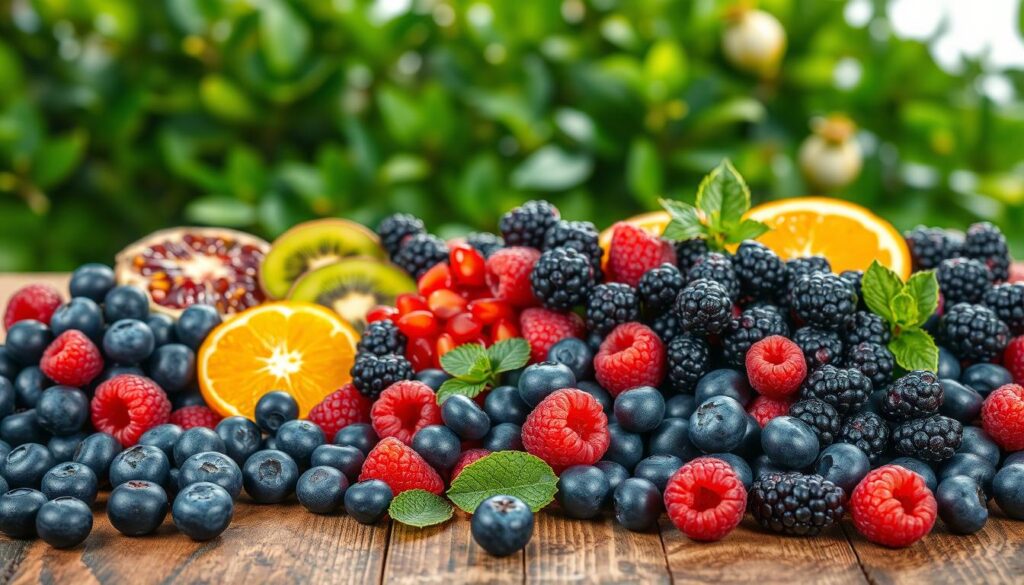
Your diet can fight inflammation, and berries are key. These small wonders are full of nutrients. They help your body fight off harm.
Blueberries, strawberries, and raspberries are great for reducing inflammation. They are colorful and full of health benefits.
- Blueberries: Highest antioxidant capacity of all common fruits and vegetables
- Strawberries: Reduce inflammatory markers in the body
- Raspberries: Contain powerful anti-inflammatory compounds
“Food is your first line of defense against inflammation,” says nutritional experts.
Choose organic berries when you can. Fresh or frozen, they’re full of nutrients. Eating a mix of berries every day is best.
Here are simple ways to add them to your diet:
- Add to morning smoothies
- Sprinkle on yogurt or oatmeal
- Enjoy as a standalone snack
Your body will be grateful for these foods.
Leafy Greens and Cruciferous Vegetables for Fighting Inflammation
Your diet is key in fighting inflammation. Green leafy vegetables are full of nutrients that help your body fight chronic health issues. They are rich in fiber and pack a punch against inflammation.
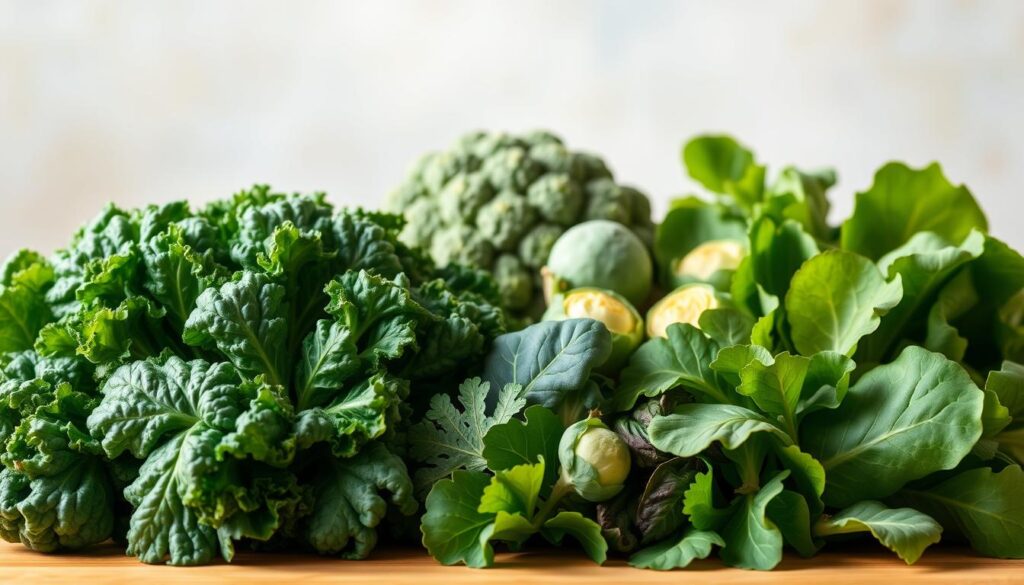
Leafy greens and cruciferous vegetables are top choices for fighting inflammation. They offer many health benefits. These veggies have special compounds that boost your body’s defense.
Nutrient-Packed Vegetable Selections
- Kale: Extremely rich in antioxidants
- Spinach: High in anti-inflammatory compounds
- Broccoli: Packed with sulforaphane
- Swiss chard: Loaded with vitamins
- Collard greens: Dense in nutrients
Best Preparation Methods
To get the most from your veggies, try these cooking methods:
- Steaming: Preserves most nutrients
- Quick sautéing: Keeps veggies intact
- Raw consumption: Keeps enzymes active
- Light blanching: Reduces enzyme inhibitors
Daily Portion Recommendations
| Vegetable Type | Recommended Daily Portion | Inflammation Impact |
|---|---|---|
| Leafy Greens | 2-3 cups | High reduction potential |
| Cruciferous Vegetables | 1-2 cups | Moderate reduction potential |
Smart Storage Tips
Keep your veggies fresh by storing them in breathable containers. Wrap them in slightly damp paper towels. Refrigerate them right away and eat within 3-5 days for best nutrition.
“Let food be thy medicine and medicine be thy food” – Hippocrates
Adding these nutrient-rich veggies to your diet can change the game for managing inflammation and boosting health.
Omega-3 Rich Fish and Seafood Choices
Omega-3 fatty acids are key nutrients that help reduce inflammation in your body. They are great for improving joint health and overall wellness. Seafood is a tasty way to get these nutrients.
Choosing the right fish can make your anti-inflammatory diet better. Wild-caught salmon is a top choice for omega-3s. Mackerel, sardines, and herring are also great for fighting joint pain.
- Wild-caught salmon: Rich in EPA and DHA omega-3s
- Mackerel: High omega-3 content with minimal mercury
- Sardines: Compact nutrition powerhouse
- Herring: Exceptional omega-3 source
It’s important to know how much seafood to eat. Experts say to have fish twice a week for the best anti-inflammatory effects.
| Fish Type | Omega-3 Content | Mercury Level | Recommended Servings |
|---|---|---|---|
| Wild Salmon | High | Low | 2-3 servings/week |
| Mackerel | Very High | Low | 1-2 servings/week |
| Sardines | High | Very Low | 2-3 servings/week |
When cooking seafood, choose grilling, baking, or poaching. Avoid deep-frying to keep the nutrients. It can add unhealthy fats.
Pro tip: Choose wild-caught fish over farm-raised for maximum omega-3 benefits and minimal contaminants.
The Best Anti-Inflammatory Foods to Add to Your Plate
Changing your diet to fight inflammation is easy and affordable. By picking the right foods, you can make tasty meals that help your body heal. Let’s look at how to eat to reduce inflammation and create a nutrition plan that’s fun and easy.
Essential Kitchen Staples
Having the right foods in your kitchen is key for an anti-inflammatory diet. Here are some must-haves:
- Extra virgin olive oil
- Fresh garlic and turmeric
- Leafy green vegetables
- Berries and citrus fruits
- Fatty fish like salmon
Shopping Guide for Anti-Inflammatory Foods
When you shop for anti-inflammatory foods, choose whole, unprocessed items. Opt for organic produce when you can. Also, pick seasonal foods to get the most nutrition and save money.
“Food is the most powerful medicine when chosen wisely.” – Anonymous Nutritionist
Budget-Friendly Options
Eating anti-inflammatory doesn’t have to cost a lot. Here are some ways to save:
- Buy frozen fruits and vegetables
- Purchase bulk dry beans and lentils
- Choose local and seasonal produce
- Compare prices between stores
- Grow your own herbs
By making smart choices, you can have a healthy diet that’s good for your wallet and lifestyle.
Powerful Herbs and Spices That Combat Inflammation
Your kitchen is full of natural ways to fight inflammation. Anti-inflammatory spices are more than just flavor boosters. They are powerful helpers for your health. These spices and herbs can naturally fight chronic inflammation.
Turmeric is a standout for its anti-inflammatory powers. It has curcumin, a healing compound. Here are some top herbs and spices to add to your meals:
- Turmeric: Reduces joint pain and supports overall immune function
- Ginger: Alleviates muscle soreness and supports digestive health
- Garlic: Boosts cardiovascular health and fights inflammatory markers
- Cinnamon: Helps regulate blood sugar and reduces oxidative stress
- Rosemary: Supports brain health and reduces muscle inflammation
To get the most from these spices, follow these tips:
- Use fresh or ground spices in cooking
- Combine spices for enhanced absorption
- Add black pepper with turmeric to increase curcumin effectiveness
- Experiment with spice blends in smoothies and teas
Introducing these natural remedies into your daily life will benefit your body. Start small, stay consistent, and enjoy the journey to better health.
Nuts, Seeds, and Healthy Fats for Inflammation Control
Discovering the power of nuts and seeds can change your life. These foods are full of nutrients that fight inflammation and boost health. Your body needs foods that naturally protect against chronic inflammation.
Healthy fats in nuts and seeds are superfoods for wellness. They’re tasty and packed with nutrients your body needs to fight inflammation.
Smart Portion Control Strategies
It’s important to control how much nuts and seeds you eat. Here are some tips:
- Aim for 1-2 ounces (about a handful) of nuts daily
- Rotate different types of nuts and seeds for varied nutritional benefits
- Choose raw or dry-roasted options over oil-roasted varieties
Optimal Timing for Consuming Healthy Fats
Timing is everything when it comes to healthy fats:
- Morning: Add chia or flax seeds to breakfast smoothies
- Midday: Sprinkle almonds or walnuts on salads
- Evening: Enjoy a small serving of pumpkin seeds as a nutrient-rich snack
“Food is your most powerful medicine when chosen wisely.” – Nutrition Expert
Remember, eating these foods in moderation is crucial. Your body will appreciate your thoughtful choices in your anti-inflammatory diet.
Building Your Anti-Inflammatory Meal Plan
Creating an anti-inflammatory diet is simple. It starts with knowing how food fights inflammation and boosts health. The Mediterranean diet is a great guide for meals that naturally reduce inflammation.
Begin with these main points for your anti-inflammatory food plan:
- Prioritize whole, unprocessed ingredients
- Include a variety of colorful fruits and vegetables
- Choose lean proteins and healthy fats
- Incorporate herbs and spices with anti-inflammatory properties
For those new to anti-inflammatory diets, meal prep is key. Here are some helpful tips for a smooth transition:
- Batch cook proteins and grains on weekends
- Prep vegetables in advance for quick meals
- Stock your pantry with anti-inflammatory staples
- Plan meals that are flexible and enjoyable
Your weekly meal plan should include foods that fight inflammation. Think vibrant salads, grilled fish, roasted vegetables, and wholesome grain bowls. The goal is to make it sustainable and enjoyable.
“Food is the most powerful medicine when chosen wisely.” – Hippocrates
Remember, an anti-inflammatory diet nourishes your body, not punishes it. Try new recipes, listen to your body, and enjoy finding tasty, healthy meals.
Common Foods That Trigger Inflammation to Avoid
Knowing which foods cause inflammation is key to a healthy diet. Some foods might seem okay but can actually lead to chronic inflammation. It’s important to know what to avoid as much as what to eat to reduce inflammation.
Start your diet to fight chronic inflammation by identifying foods that cause it. Here are the top foods to limit or avoid:
- Refined sugar – Increases insulin levels and triggers inflammatory responses
- Processed vegetable oils
- Artificial trans fats
- Refined carbohydrates
- Excessive alcohol
Hidden Sources of Inflammatory Ingredients
Many packaged foods have hidden inflammatory ingredients. Processed snacks, sugary drinks, and even healthy-looking granola bars can have these ingredients. It’s crucial to read nutrition labels to choose foods that calm the body.
Healthy Substitutions for Inflammatory Foods
Simple recipes can help you swap out bad foods for good ones. Here are some swaps:
- Replace soda with herbal tea or infused water
- Choose whole grains instead of refined carbohydrates
- Use olive oil instead of vegetable oil
- Select fresh fruits over processed desserts
By choosing foods wisely, you can lower inflammation and help your body heal.
Conclusion
Choosing an anti-inflammatory diet is more than just eating right. It’s a key way to fight inflammation. Starting your health journey means learning how certain foods can help.
Creating meals that fight inflammation is easy. Just add foods like berries, fatty fish, leafy greens, and turmeric to your meals. These foods can make a big difference, especially for those with arthritis.
Even small diet changes can make a big difference in your health. Start by adding these healthy foods to your meals a little at a time. Every choice you make helps your body fight inflammation and feel better.
Your body can heal itself with the right food. By focusing on anti-inflammatory foods, you’re taking a big step towards a healthier life. You’ll feel more energetic and balanced.

